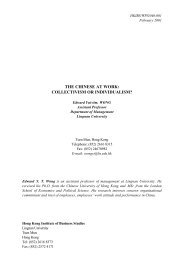West Rail vs. Bus - Lingnan University Library
West Rail vs. Bus - Lingnan University Library
West Rail vs. Bus - Lingnan University Library
Create successful ePaper yourself
Turn your PDF publications into a flip-book with our unique Google optimized e-Paper software.
Table 5.2.8 Crosstabulation of household income and transportation mode<br />
Household income Transportation mode Total<br />
<strong>West</strong> <strong>Rail</strong> <strong>Bus</strong> Asymp. Sig. (2-sided)<br />
Below $15,000 51.9% 48.1% 100.0%<br />
Between $15,000 - $29,999 38.9% 61.1% 100.0%<br />
$30,000 or above 25.0% 75.0% 100.0%<br />
0.078<br />
Total 37.2% 62.8% 100.0%<br />
To conclude, all the results of the proposition four are either insignificant or show<br />
opposite relations. So the propositions that white-collar, young, highly educated and<br />
high household income people are more willing to travel <strong>West</strong> <strong>Rail</strong> are not support.<br />
Proposition 5: The Government “railway first” policy cause passengers shift from bus<br />
to <strong>West</strong> <strong>Rail</strong><br />
The questionnaire contains three statements of Government policy and the<br />
deterioration of bus service on a 7-point Likert scale. Two of them are related to the<br />
Proposition 5, which is “Government “railway first” policy lead to deteriorate of bus<br />
service” and “Deterioration of bus service increase the interest of taking WR”.<br />
From table 5.2.9, the mean of the statement of Government “railway first”<br />
policy and increasing the interest of taking WR is 3.38. The mean of the statement of<br />
deterioration of bus service increase the interest of taking <strong>West</strong> <strong>Rail</strong> is 3.3. It shows<br />
that most passengers are slightly disagreeing with the statements. So the result seems<br />
53









